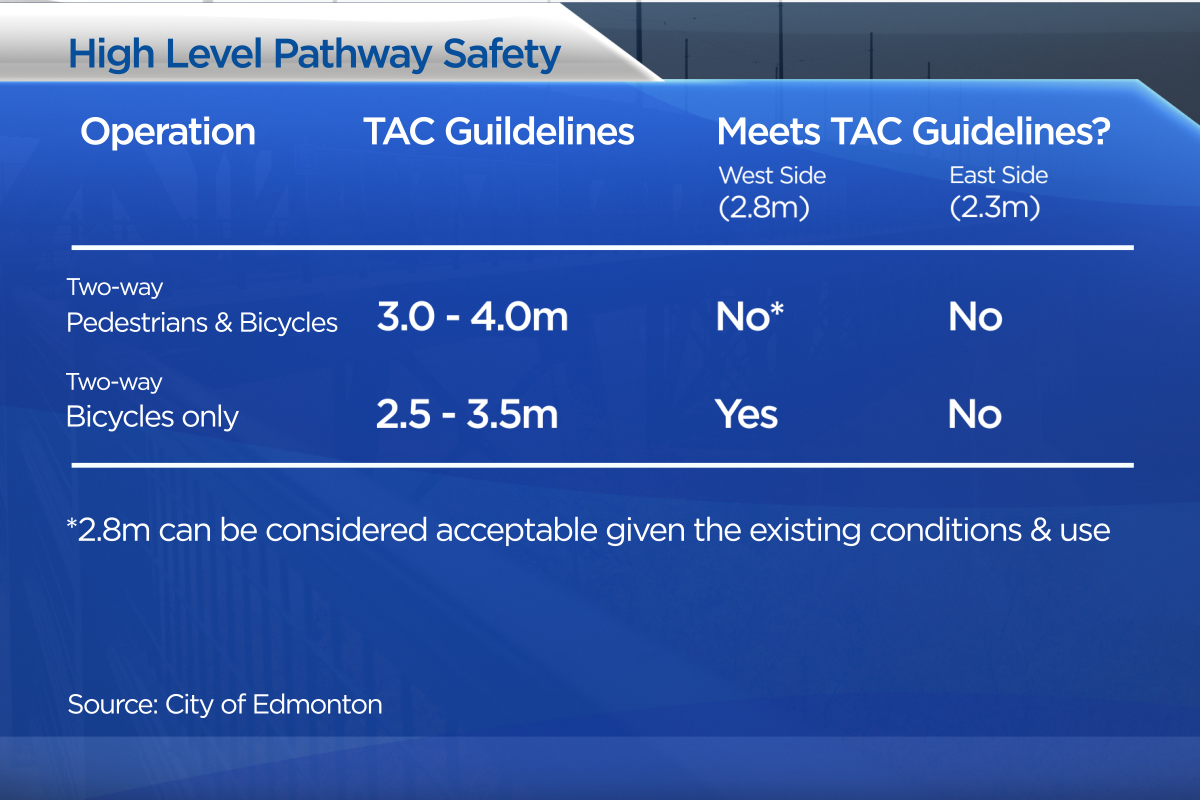Residents have been bringing up concerns over the High Level Bridge pathways being too narrow ever since suicide barriers were put in place, and now, a safety audit backs up the claims.

A report given to the City Executive Committee showed there are safety concerns about having two-way bicycle and pedestrian traffic on the east side of the bridge.
WATCH: ‘We hope this ends what’s been a fairly dark chapter’: City on High Level Bridge suicide barriers
The study suggests that pathways should be at least three to four metres wide to accommodate cyclists and pedestrians on both sides of the bridge. Currently, the pathway on the west side is 2.8 metres wide and that’s close enough, according to the report. On the east side though, it’s only 2.3 metres wide and the audit called that width “substandard.”
“There are already people who will not use that bridge – both cyclists and pedestrians – because of the congestion and the discomfort they feel,” Chris Chan, executive director of the Edmonton Bicycle Commuters, said.
WATCH: Suicide barriers on High Level Bridge make span harder to navigate
Chan added that changing the bridge pathways to one-way routes isn’t feasible.
“It reduces capacity,” he said. “As we try to increase active transportation, reducing capacity isn’t a long-term solution.”
The long-term options that are being considered include changing the structure of the bridge by widening the pathways or putting a pathway on top of the High Level Bridge. City administration said those options can’t be considered until the bridge comes up for renewal, which won’t happen for at least five years.
In the meantime, the city said it will install additional signage and undertake an education campaign to encourage cyclists and pedestrians to slow down and pay attention on the busy corridor.
“Typically, we want to build a corridor that’s wide enough to accommodate all modes,” Adam Laughlin, general manager of Integrated Infrastructure Services at the City of Edmonton, said. “In some instances like this, we don’t have the space, so we need to educate and reinforce the right behaviours on these tight corridors.”
Lighting, bumper guards and changes to the intersections at either end of the bridge have also come up as potential ways of improving safety, but Laughlin said those options cost a significant amount of money and will also have to be looked at in the future as part of the High Level Bridge renewal.
The Edmonton Bicycle Commuters has been tracking complaints made by its members on issues they had when just one side of the bridge was open during the construction of the suicide barriers.
WATCH: ‘We hope this ends what’s been a fairly dark chapter’: City on High Level Bridge suicide barriers
“There were pedestrians who were hit, there were bikes running into the barriers,” Chan said. ” There were at least a couple of times where EMS had to respond.”
Chan said since both sides have reopened, those complaints have lessened significantly.
Although there are a number of options that the city can take, the one thing not on the table is removing the suicide barriers. Councillors said in an earlier presentation by a paramedic, it was noted at least two lives have been saved by the devices.



Comments